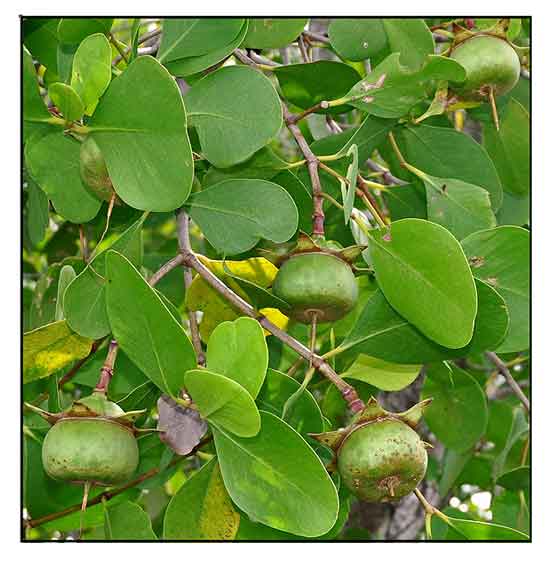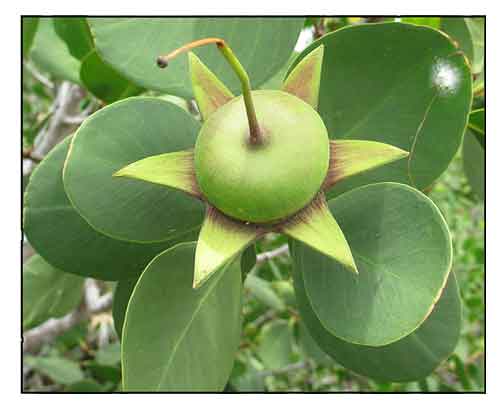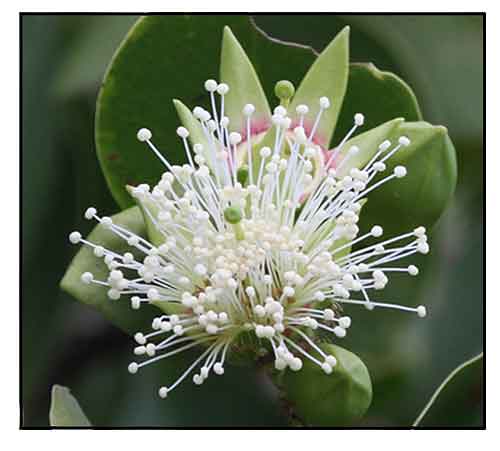 Gen info Gen info
- Lythraceae is a family of flowering plants, including 32 genera, with about 62o species of herbs, shrubs, and trees. Lythraceae species are most often herbs, and less often shrubs or trees; the shrubs and trees often have flaky bark.
- Etymology: The genus name Sonneratia honors Pierre Sonnerat (1749-1841), French botanist and explorer. The species epithet alba derives from Latin, meaning 'white', referring to the white petals and stamens of the flowers.
Botany
• Growth form: A tree, with a broad, spreading canopy, usually 15 - 20 m tall, and sometimes up to 30 m tall. Trunk: Cream-colored to brown bark, with smooth, fine, longitudinal fissures. Roots: It bears thick and blunt pneumatophores (conical roots that emerge vertically from the ground) that are up to 1 m tall. Foliage: Stalked, opposite leaves are elliptic to ovate or obovate in shape, with a rounded or broad leaf tip, 5-11 cm long and 4-8 cm wide. Leaf stalks are 6 - 15 mm long and has vestigial glands at the base. Flowers: White petaled flowers bear numerous white stamens which give it a powder-puff like appearance. White stamens are soon shed after blooming. Petals measure about 13 - 20 by 0.5 - 1.5 mm. The flowers are borne in clusters of 5-8, and only bloom at night. Fruit: Fruits are hard, fleshy berries that are round and flattened, with a persistent calyx at the base, 2-4.5 cm across, ripening green. (2)
• Trees, 3-15(-30) m tall, spreading, with broad, rather lax crown. Pneumatophores 30(-100) cm, thick, blunt. Petiole 5-15 mm; leaf blade adaxially pale, elliptic to ovate or obovate, 5-11 × 4-8 cm, base rounded, apex broad, rounded, with broad recurved mucro. Flowers 5-8-merous. Floral tube shiny, 3-3.5 cm at anthesis, smooth, often 6-ribbed; sepals adaxially strongly tinged red, 1.3-2 cm, ± erect at anthesis, recurved in fruit. Petals white, linear, 1.3-2 cm × ca. 1 mm, or variably semipetalous to absent. Staminal filaments white. Fruit 2-4.5 cm in diam., ca. equal to width of floral tube. Seeds falcate. (Flora of China)
Distribution
- Native to the Philippines. (1)
- Also native to Aldabra, Andaman Is., Bangladesh, Bismarck Archipelago, Borneo, Cambodia, Caroline Is., Comoros, Gilbert Is., Hainan, India, Jawa, Kenya, Lesser Sunda Is., Madagascar, Malaya, Maldives, Maluku, Marshall Is., Mozambique, Myanmar, Nansei-shoto, New Caledonia, New Guinea, Nicobar Is., Northern Territory, Queensland, Seychelles, Solomon Is., Somalia, Sri Lanka, Sulawesi, Sumatera, Tanzania, Thailand, Vanuatu, Vietnam, Western Australia. (2)
 Constituents Constituents
- Study of bark isolated a new lupane-type triterpenoid, 3ß-hydroxy-lup-9(11),12-diene, 28-oic acid (1), along with two known lupane-type triterpenoids, lupeol (2) and lupan-3ß-ool (3). (see study below) (6)
-
Primary metabolites include carbohydrates and sugars, proteins and amino acids, lipids and fatty acids, while secondary metabolites include triterpenoids, phenolics, steroids, among others. Studies on leaf, fruit and bark have yielded all major phytochemical classes such as alkaloids, phenolics, flavonoids, saponins, tannins, terpenoids, quinones, and steroids. (9)
- In Japan, study for chemical characterization of floral scents
reported four main compounds viz. trans-β-ocimene (a mono-terpene) (1), 2, 4-dithiapentane (an organosulfur) (2), 2-heptanone (a ketone) (3), and methyl-2-methylbutanoate (a fatty acid ester) (4). (9)
- Study of nutritional content of mangrove syrup from S. alba fruit revealed protein 1.20%, fat 0.20%, carbohydrates 3.5%, and vitamin C 55.30%. Fruit processed into syrup showed high nutritional and antioxidant value and also rich in fiber. (11)
- GC-MS analysis of dried leaves powder extract revealed
mesitylene, benzene-1,2,4-trimethyl, benzene-1-ethyl-3-methyl, and benzene-1-ethyl-2-methyl. (see study below) (12)
- GC-MS analysis of methanol extract of roots revealed five dominant compounds namely: Methyl 2-hydroxy-eicosanoate (19.55%); 4H-1-Benzopyran-4-one, 3,5-dihydroxy-2-(4-hydroxy-3-methoxyphenyl)-7-methoxy (16.48%); 4-((1E)-3-Hydroxy-1-propenyl)-2-methoxyphenol (10.06%); Benzamide, N-[4-(2-naphtyl)-2-thiazolyl]- (9.40%); and 2,3-Dihydro-3,5-bis(3-methoxyphenyl)-1H-inden-1-one (6.52%). (see study below) (16)
- Study of twigs isolated three pentacyclic triterpenoids, lupeol (1), oleanolic acid (2), and betulinic acid (3), together with 2,6-dimethoxy-p-benzoquinone (4), a mixture of stigmasterol (5) and ß-sitosterol (6). (see study below) (17)
Properties
- Studies have suggested antibacterial, antidiabetic, antioxidant, antimicrobial, cytotoxicity, antimalarial, biolarvicidal, antimycobacterial properties.
Parts used
Fruit, pulp, bark, leaves, roots.
 Uses Uses
Edibility
- Fruits are edible, eaten raw.
- Sour fruits are used to flavor fish.
- Ripe fruits are said to taste like cheese.
- Leaves are edible; eaten raw or cooked.
- In Goa, India, ripe fruits are used for making curries, while unripe ones used for making jellies, pickles, and vinegar. (9)
Folkloric
- No reported folkloric medicinal use in the Philippines.
- Fruit pulp used as compress to stop bleeding.
- In Indian folk medicine, used in traditional medicine for treatment of skin disorders, bleeding injuries, diarrhea. (9)
- Extracts or fruit pulp used as poultice for treating muscular swellings and sprains. (9)
- In Indian and Indonesia folk medicine, used for treating sprains, wounds, diarrhea, and fever. (9)
Others
- Wood: Resistant to shipworm and pests, used for construction of houses, bridges, boats, wharves. Used for flooring, making furniture and musical instruments. (2) Wood corrodes metal because of high mineral content. Pneumatophores are made into floats for fishing nets. (5) In East African coastal countries, wood used for making ribs and keels of large watercraft (dhows) and oars, paddles, and masts. (9)
- Fuel: Wood used as firewood; while producing a lot of heat, it also produces a lot of ash and salt. (5)
- Agroforestry: Pagatpat is the dominant mangrove species in seaward areas with mud and sand substrate, and high salinity water. It can effectively withstand conditions of wind exposure and wave action, and are excellent for coastal protection. For reforestation, they have to be propagated in nurseries. (3)
- Fodder: In eastern Africa, leaves used as camel fodder.
- Alcohol: In Indonesia, natives used bark extract to delay fermentation and preserved alcoholic palm-based drink. (9)
Studies
• Antibacterial Triterpenoids / Bark: Study of bark isolated a new lupane-type triterpenoid, 3ß-hydroxy-lup-9(11),12-diene, 28-oic acid (1), along with two known lupane-type triterpenoids, lupeol (2) and lupan-3ß-ool (3). Using broth microdilution method, all compounds exhibited antibacterial activity against Gram(+) Staphylococcus aureus ATCC 6538 and Streptococcus mutans ATCC 25175, with MICs ranging from 15-33 to 35-55 µg/mL respectively. (6)
• Anti-Diabetic / Polysaccharides: Complex polysaccharides isolated from the mangrove plant showed effective antidiabetic activity in diabetic-induced experimental mice. Administration of polysaccharides significantly reduced blood glucose level to 19.2% in the first 6 hours, and controlled at 66.6% in the next 12 hours. (7)
• Valorization of Leaves as Functional Salt Preparation: Mangrove leaves of S. alba have bioactive components that have potential as natural antioxidants, NaCl salts, macro and micro minerals, and antibacterial activities. Study characterized S. alba leaves as a functional salt preparation based on leaf age. Valorization of leaves was carried out via extraction method using distilled water on parameters of yield, mineral analysis, Na:K ration, NaCl analysis, antioxidant activity, and organoleptic tests. The salt characteristics of young leaves included a yield of 6.67%, salty followed by bitter taste, antioxidant activity IC50 14.34 g/mL, dominant minerals of sodium (5.632%) and potassium (4.542%), Na:K ratio 1.24, and NaCl content of 22.88%. Salt characteristics of old leaves showed a yield of 6.37%, salty followed by bitter taste, antioxidant activity IC50 of 21.12 g/mL; dominant minerals of 7.686% sodium amnd 3.294% potassium; ratio Na:K 2.33, and 27.01% NaCl content. Both young and old mangrove leaf salts fulfilled dietary salt standards. (8)
• Floral Scent: In Japan, study for chemical characterization of floral scents
reported four main compounds viz. trans-β-ocimene (a mono-terpene) (1), 2, 4-dithiapentane (an organosulfur) (2), 2-heptanone (a ketone) (3), and methyl-2-methylbutanoate (a fatty acid ester) (4). Compound 2 and the floral scent is attributed to the nocturnal pollination by bats. (9)
• Cytotoxicity / Antioxidant / Antimicrobial / Bark: Study evaluated the antioxidant, cytotoxic, and antimicrobial activity of S. alba bark. Brine shrimp lethality assay showed LC50s for best fit line slope of 0.812, 14.94, 0.831 and 3.288 µg/ml for standard (Vincristine sulphate), n-hexane, carbon tetrachloride and chloroform soluble partitionate of methanolic extract respectively. The CCl4 soluble fraction revealed moderate activities against Bacillus cereus, B. subtilis Sarina lutea, Pseudomonas aeruginosa, and Shigella dysenteriae test organisms. The CCl4, chloroform soluble partitionate of the ME and crude ME showed significant antioxidant property using DPPH assay, with the chloroform partitionate of crude extract showing highest IC50s of 12 and 14 µg/ml respectively. (10)
• Antioxidant / Leaves: Study evaluated the phytochemicals and antioxidant activity of S. alba mangrove dried leaves powder. A chloroform extract showed strong antioxidant activity, which was attributed to tannin, phenol, and steroid content. (see constituents above) (12)
• Antimalarial / Leaves: Study evaluated antimalarial effects of ethanol extract of leaves in a mouse model with mice injected intraperitoneally with Plasmodium berghei ANKA strain. Results showed significant suppression of parasitemia at dose of 300 mg/kbw, with 77.34% reduction. Mice given 150 mg/kbw dose showed 62.35% suppression and 43.53% suppression with 75 mg/kbw dose. (13)
• Anticancer Potential / Roots: Study evaluated perepat (Sonneratia alba) root extract for chemical compounds with cytotoxic activity. FT-IR spectrometry isolated a ß-sitosterol compound with a high similarly chromophore. Toxicity study using BSLT (Brine Shrimp Lethality Test) showed the acetone isolated extract possessed lower cell death average 100% (start 200 µg/ml) than isolate extract 80% (50 µg/ml). Toxicity of the total extract was LC50 23.98 µg/ml, compared to isolated at 10.04 µg/ml. The toxicity of the extract lower than the isolate suggested both can be classified as very toxic, and has potential to be developed into anticancer drug compounds. (14)
• Effect on HeLa Cell Viability / Leaves: Study evaluated the effect of S. alba mangrove leaf powder extract on HeLa cell viability. Solvents use include n-hexane, ethyl acetate, and ethanol. Phytochemical screening yielded alkaloid compounds, steroids, triterpenoids, and tannins. LC-MS yielded compounds including diosmetin, caffeine, and turmeron. The ethyl acetate extract of leaves showed cytotoxicity against HeLa cell viability with IC50 value of 478.63 µg/ml. (15)
• Larvicidal / Aedes aegypti Instar Larvae / Roots: Study evaluated the biolarvicidal activity of S. alba root extract against Aedes aegypti instar III/IV larvae with concentrations of 0.1, 1, 10, 100, and 1000 ppm for 24 hours. The methanol extract showed best larvicidal activity compared to chloroform and n-hexane extracts, with mortality of 69.33% at concentration of 1000 ppm and LC50 of 1265 ppm. GC-MS analysis of methanol extract revealed five dominant compounds. Results showed larvicidal activity and basis to develop biolarvicides from nature, which are safer for human health and environment. (see constituents above) (16)
• Antimycobacterial / Antimalarial / Twigs: Study of twigs isolated three pentacyclic triterpenoids, lupeol (1), oleanolic acid (2), and betulinic acid (3), together with 2,6-dimethoxy-p-benzoquinone (4), a mixture of stigmasterol (5) and ß-sitosterol (6). Compounds 2 and 3 exhibited antimycobacterial activity with IC50s of 25 and 50 mg/ml respectiively. Compound 4 exhibited antimalarial activity against Plasmodium flaciparum with IC50 of 3.08 mg/ml. (17)
• Encapsulation of Leaves as Antioxidant Supplement: Study evaluated the characteristics of ethanol extracts of S. alba leaves encapsulated using inulin coating. In vitro bioavailability testing of ethanol extract encapsulation from perepat leaves with inulin coating of PKL showed an increase in percentage of drug release in the pH buffer 1.2. In pH buffer 7.4 from the last minute to miute 240, there was increase in drug release, reaching 98.54%. Results indicate encapsulation of the extract has good potential as capsule supplement. (18)
• Gold Nanoparticles / Antioxidant, Anti-Inflammatory, Anticancer / Fruits: Study reports on the rapid and eco-friendly method of synthesis of gold nanoparticles using ripe Sonneratia alba fruit extract (SF-AuNPs) as bioreductant, stabilizer, and capping agent. Fluorescence spectroscopy evaluated the biophysical interactions between SF-AuNPs and trypsin protein. SF-AuNPs were investigated using antioxidant and anti-inflammatory assays. Anticancer studies of SF-AuNPs on lung cancer cell line (A549) were more effective than S. alba aqueous extract. Results provide insights into safe and practical applications of SF-AuNPs in biomedical areas. (19)
• Coagulant Activity / Fruits: Study evaluated the coagulant activity of fresh fruit extracts of S. alba using the prothrombin time method. Aqueous extracts were prepared from boiling in concentrations of 5 ppt, 25 ppt, and 50 ppt and labeled as TWA5. TSA25, and TSA50, respectively. Results showed TSA5 and TSA25 exhibited coagulant activity at 202.67% and 162.18%, respectively. Results of prothrombin time revealed that the aqueous extract with lower concentration exerted anticoagulant activity. The coagulant activity may be attributed to tannins. (20)
Availability
Wild-crafted.
|

![]()






